Actually, it was the day after Christmas, but that doesn’t make for nearly as catchy a title. The weatherman was calling for a high temperature near thirty with a 10 mph wind, but I was really wanting to get out and look for some crayfish. Plus it was go crayfishing or stay home and endure the Food Network all day.
The first stop was going to be Turner Mill Spring on the Eleven Point River. I wanted to look in the spring branch to see if the Coldwater Crayfish (Orconectes eupunctus) was present there as it is in Greer Spring. But as I was driving down Highway 19, I decided I just didn’t want to drive the seven miles of dirt road that it would take to get there. And I could access the river at Greer Crossing which is just downstream of the 19 Bridge.
The boat ramp at Greer is in a backwater off of the main river. The river itself is a long pool too deep for me to access even with chest waders and the bottom is sand/very small gravel without rocks of any size. I scouted upstream, following the Ozark Trail some 300 yards to a gravel bar almost directly under the bridge. Here there is a fast, shallow riffle leading into the long pool below and off to one side is a nice backwater with a circulating current. Most importantly, there were plenty of good sized rocks for crayfish to hide under.
I had left the chest waders in the truck and was wearing only knee boots so I started looking in the riffle first, figuring there was less chance of getting my feet wet there. I only had to turn a couple of rocks before finding my first crayfish, an Orconectes eupunctus (Coldwater Crayfish.) I placed him in my bucket and took these photos with my camera submerged in the water to avoid the reflections on the surface.
O. eupunctus is not a large crayfish, reaching a maximum size of less than three inches. This species is the dominant crayfish in the Eleven Point River below Greer Spring though it inhabits neither the river much above Greer nor its tributaries (Pflieger, 1996.) It’s also common in the neighboring Spring River drainage (Pflieger, 1996) and has been collected at least once from the Strawberry River in Arkansas (Wagner, et al., 2008.) However, a population of O. neglectus chaenodactylus – the Gap Ringed Crayfish – was introduced into the West Fork of Spring River some time between 1984 and 1998 and has apparently displaced O. eupunctus from that stream as well as the South Fork of Spring River near its confluence with the West Fork (Larson and Magoulick, 2008; Magoulick and DiStefano, 2007.)
My camera, a Canon D10, does not have a manual mode so I was shooting basically in full auto mode and the camera chose an aperture that did not allow sufficient depth of field. That’s why the ends of the legs, the sides of the claws and part of the edge of the tail fan are blurry. The photos are good enough to show the main characteristics of the crayfish (the paired yellowish-white spots on the first abdominal segment, the blue/green head and claws, etc.) and the color is mostly accurate other than the carapace being too dark. It should be less black and more of a reddish/rusty color.
I released that crayfish and returned to the river. Holding the net downstream of a particularly nice rock, I slowly lifted the rock and saw the current carry a crayfish into the net. Looking in the net, I found I actually had two crayfish, both Cambarus hubbsi (Hubb’s Crayfish.)
This was a little surprising since I wasn’t used to finding C. hubbsi in shallow, swift riffles, but rather in deeper water with less current. Granted most of those were from the Jacks Fork, but all the C. hubbsi I’ve found in the Eleven Point previously were in a side channel area, two to three feet deep with almost no current.
In Missouri, C. hubbsi occurs in the southward draining rivers of the Ozarks, from the St. Francis in the east to the James River in the west. It’s absent from the North Fork drainage and much less common in the streams to the west (Pflieger, 1996.) It also occurs well south into Arkansas, though I don’t have much information on it’s exact range there. Unfortunately, it too has apparently been displaced in the West Fork of the Spring River by O. neglectus (Magoulick and DiStefano, 2007.)
After putting these two crayfish back in the river, I poked around for a while, found more of the same two species but no others, so I headed back to the truck. From Greer, I headed south to Thayer and the Warm Fork of the Spring River looking for one of Missouri’s rarest crayfish. I’ll pick things up from there in part two which I hope to have posted in a day or three.
| References Cited: |
| Larson , E.R. and D.D. Magoulick. 2008. Comparative life history of native (Orconectes eupunctus) and introduced (Orconectes neglectus) crayfishes in the Spring River drainage of Arkansas and Missouri. American Midland Naturalist 160:323-341. |
| Magoulick, D. D. and DiStefano, R. J. 2007. Invasive Crafish Orconectes neglectus Threatens Native Crayfishes in the Spring River Drainage of Arkansas and Missouri. Southestern Naturalist 6(1): 141-150. |
| Pflieger, W.L. 1996. The Crayfishes of Missouri. Missouri Dept. of Conservation, Jefferson City, MO. 152 pp. |
| Wagner, B.K., C.A. Taylor, and M.D. Kottmyer. 2008. Stream Crayfish of the Northeast Arkansas Ozarks. Final Report – State Wildlife Grant Project T20-8. Arkansas Game and Fish Commision, Little Rock, AR. 76 pp. |
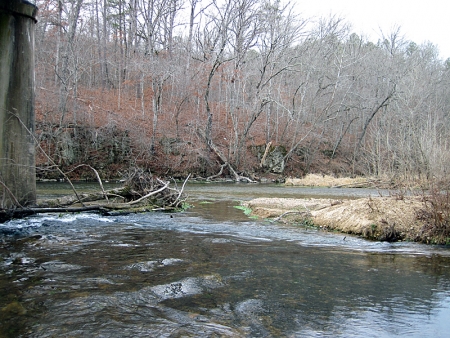
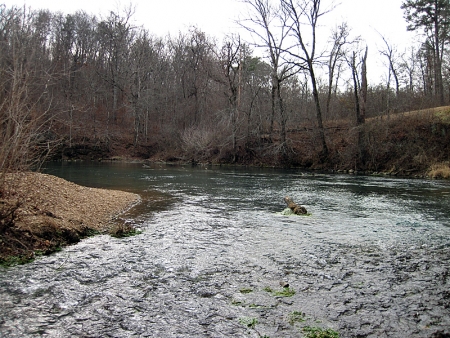
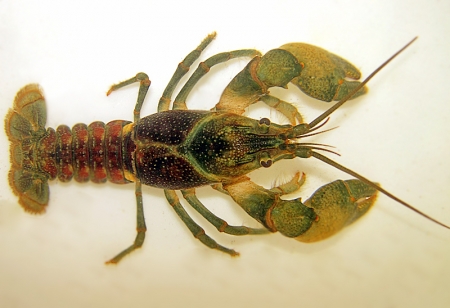
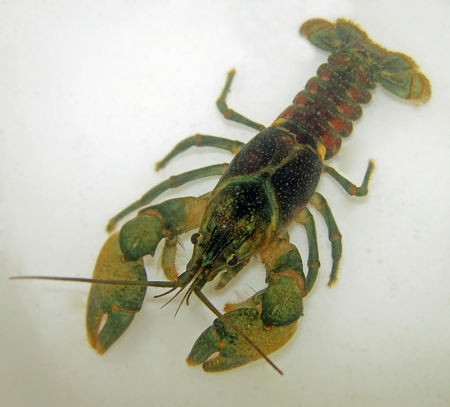
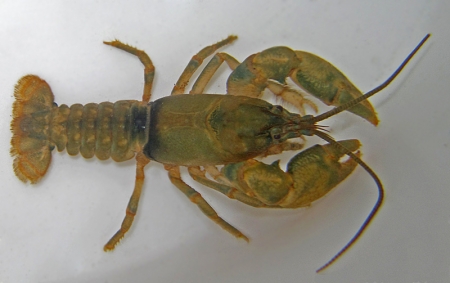
Dan,
It might interest you to know that I am currently working on my Master’s degree at the University of Arkansas, and my thesis concerns the Coldwater Crayfish. I’ll be looking at how natural and anthropogenic factors affect the observed densities and distributions of the Coldwater Crayfish. I’m working with Dr. Magoulick, Brian Wagner, and Bob DiStefano, all of whom you have cited in the above blog.
Those are some great pictures; I’ll have to make a trip up there to try and catch a few myself. My sites are randomly selected, which means I rarely collect O. eupunctus given it’s extremely limited natural range. I have, however, collected several O. eupuntus in the mainstem of the Strawberry River with Brian Wagner (AGFC) last autumn.
You have a great website–keep up the good work.
Hey Matthew,
That does interest me very much. I’m looking forward to seeing what results you come up with – when do you expect to complete your thesis? I’ve spoken with Bob via email a few times, but I only know the others by reading their work.
I’m glad you liked the photos – I wasn’t terribly happy with them at the time, but looking back now, they’re not as bad as I thought. I’ve been back to the Eleven Point twice in the last month and have some better photos that I’ll get around to posting soon, I hope.
I’ve never been on the Strawberry, but I’m planning to rectify that before the summer is over. Any places you’d recommend?
Thanks for the encouragement and for taking the time to leave a comment. Sometimes it feels like I’m working in a vacuum here, so any feedback or comments I get are greatly appreciated. Come back anytime!
Dan
I expect to compete my thesis in May 2013. We are completing the second field season this summer. If you’re looking to go on the Strawberry, then bigger is better. We found very little in the way of crayfish on the 3rd order segment we sampled. However, we sampled a 5th order segment of the Strawberry (the exact location escapes me) last fall and collected O. eupunctus, O. ozarkae, O. punctimanus, and C. hubbsi. We also collected Arkansas Saddle Darters. As mentioned, I don’t recall the exact location off the top of my head, but it was a 5th order segment that we accessed via a low water bridge crossing. It’s worth a visit.
Matt